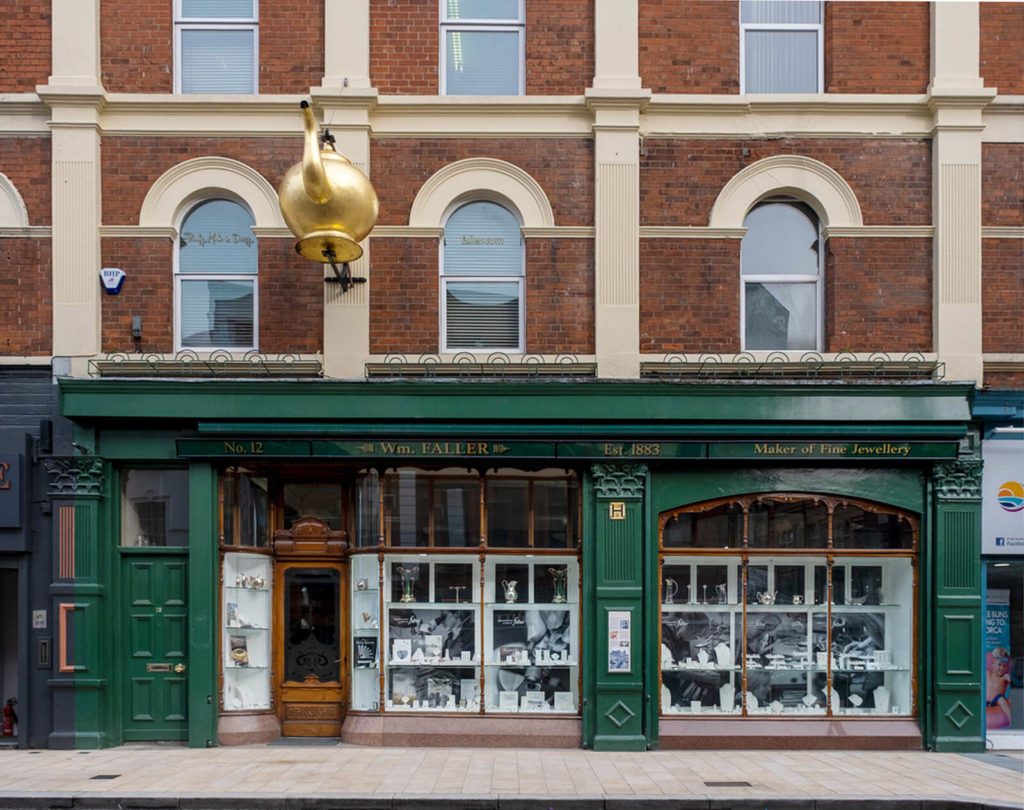History of Faller

Origins
WILHELM FALLER was originally a native of the small village of Schönwald in the beautiful Black Forest region of southwestern Germany close to the French border. With its distinctive half-timbered farmhouses, quaint red-roofed towns, vast dark evergreen forests, mountain peaks, lakes, rivers, and lush valleys, the Black Forest even then was a popular destination for holidaymakers and visitors. The village was within striking distance of the old cities of Freiburg (Germany), Strasbourg (France), and Zurich (Switzerland).
The Black Forest was also the home of the world-famous cuckoo clock – the first such device was actually claimed to have been invented in a Schönwald workshop as far back as 1737. The area became renowned for the quality of its craftsmanship and the little wooden clocks became popular not only in Germany but across continental Europe.

1860's - 1870's
By the time Wilhelm Faller was born in Schönwald in 1860, clock-making was to the Black Forest economy what shirt-making was to the city of Derry at that time. His father like so many around him was a clockmaker and encouraged his sons in the same trade. In 1873 Wilhelm followed family tradition undertaking a three-year apprenticeship in clock-making in a local clock factory. Once completed Wilhelm looked for work and decided to follow his elder brother Stephen in finding opportunities overseas.
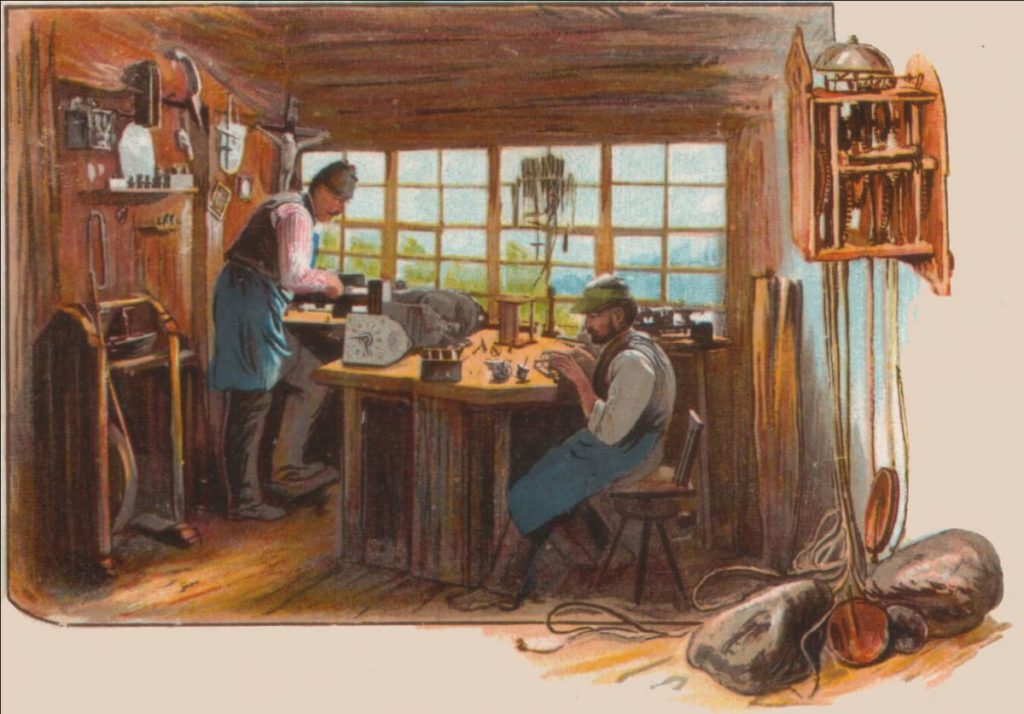
16 year-old Wilhelm left Schönwald for Ireland in 1876 to join Stephen in Athlone. His father gave him a 22ct gold 10 Mark coin as an emergency fund should problems arise. The coin still remains within the family.
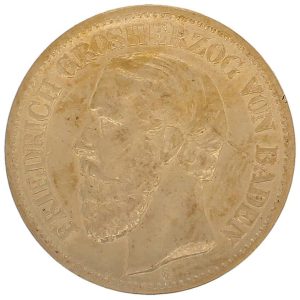
1875 date 22ct gold 10 Mark coin
In Athlone, the pair laid the foundations for what would become not one but two successful businesses. Four generations on, Stephen Faller’s descendants recall his unique manner of making a sale: “He was known to cycle the length and breadth of the West of Ireland, with clocks on the back of his bicycle, leaving them at various customers homes on a trial basis. By the time he returned some weeks later the families had become attached to his trusty and distinctive clocks. Invariably a sale was made.”
William spent two years selling his fair share of clocks since around the West of Ireland. By this time Stephen opened his first shop near the docks in Galway city in 1879, his younger brother Wilhelm had already relocated 170 miles north to the bustling city of Derry the previous year.
During the nineteenth century, Derry city’s population quadrupled. People moved into the town after the terrible famine in the countryside, the shirt factories provided a degree of prosperity and Derry moved up from being the twelfth largest town in Ireland to being the fourth. It was a time of great development in the city and 18-year-old Wilhelm had spotted the opportunity to establish his own venture. Traveling the length and breadth of Donegal and Derry with a backpack of ‘wag on the wall’ clocks, cuckoo clocks and other wooded timepieces from Germany this soon proved successful.
1880's - FerryQuay St. Shop
In 1883, 23-year-old Wilhelm made two major decisions – he anglicised his name from ‘Wilhelm’ to ‘William’ and he opened his first shop in Derry city centre at 25 Ferryquay Street.
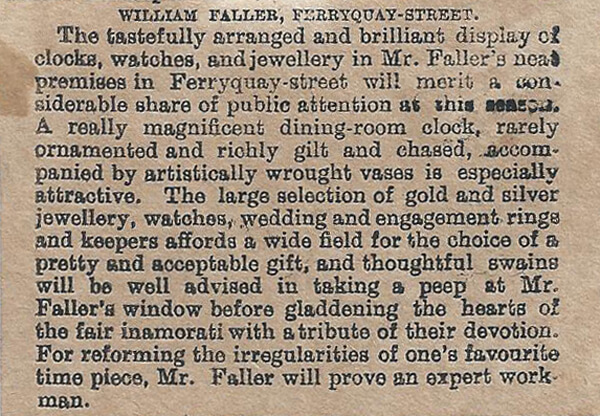
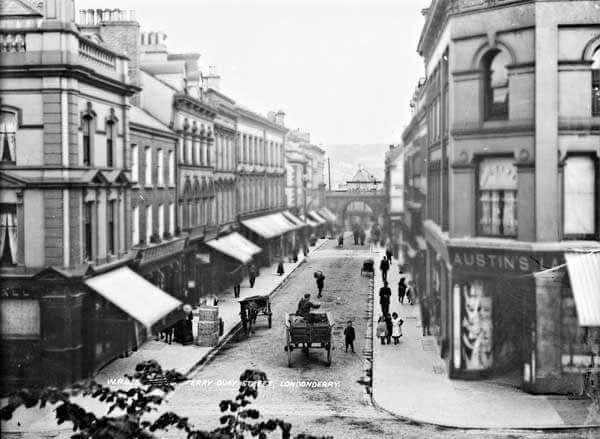
He also continued to sell his clocks throughout counties Donegal and Derry – using the rail network to increase his range far from Derry city and, by 1897, he had six agents on the road selling Faller clocks.
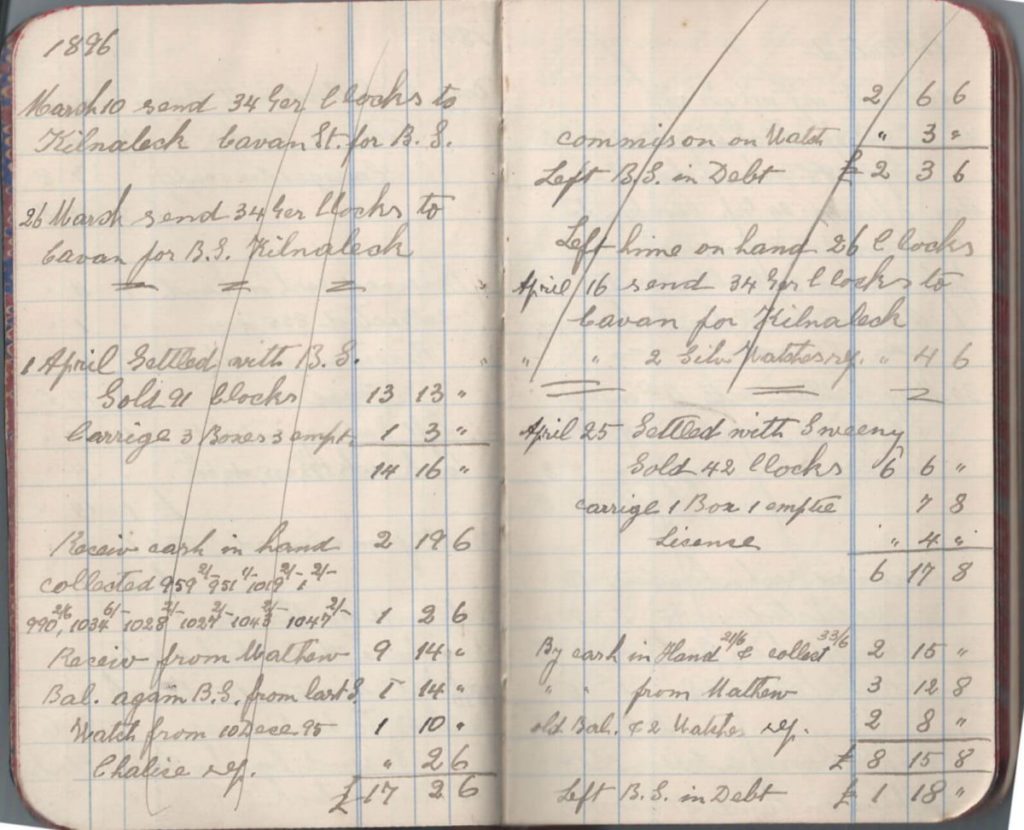
Twenty-one years had passed since William Faller set foot in Ireland but as the turn of the century approached, he had already made his mark as a hard-working and shrewd businessman.
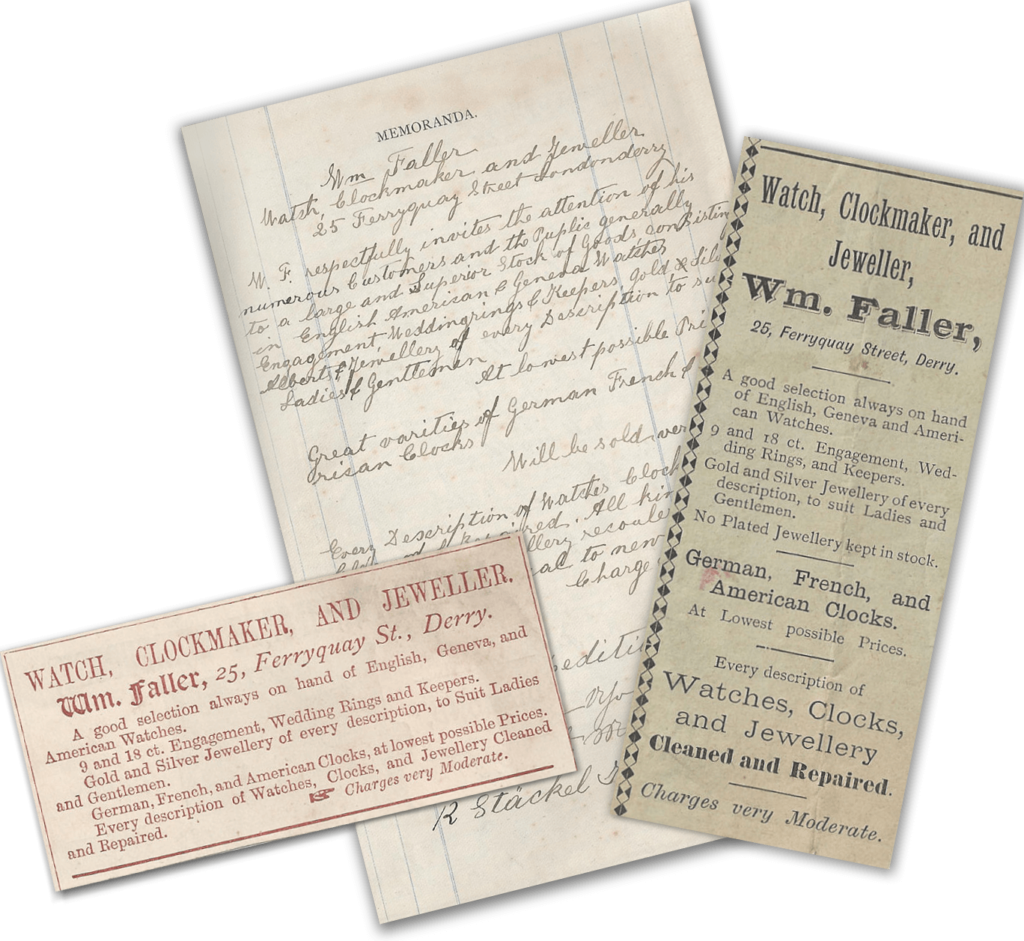
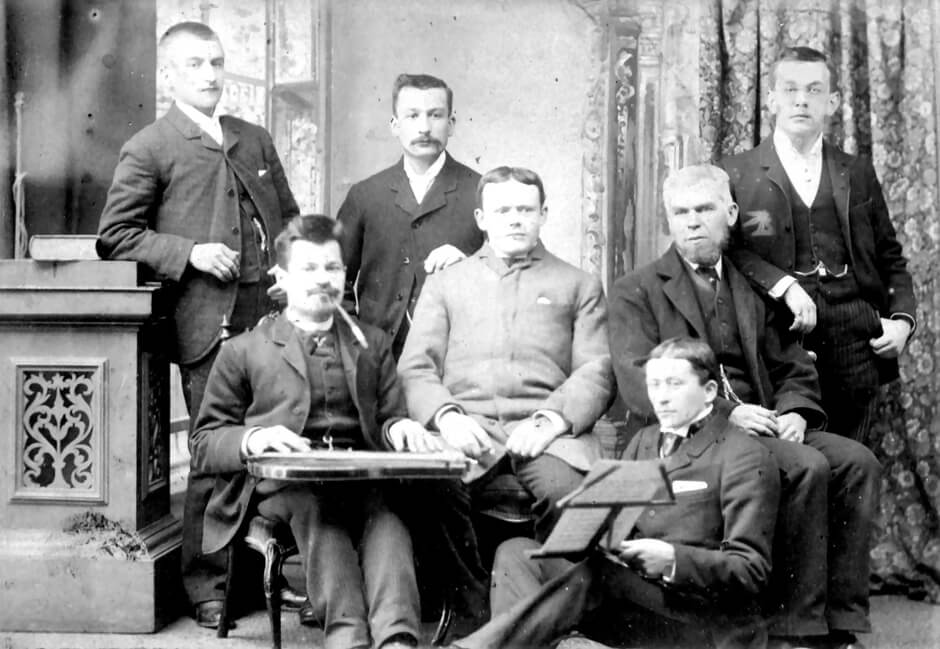
1890's
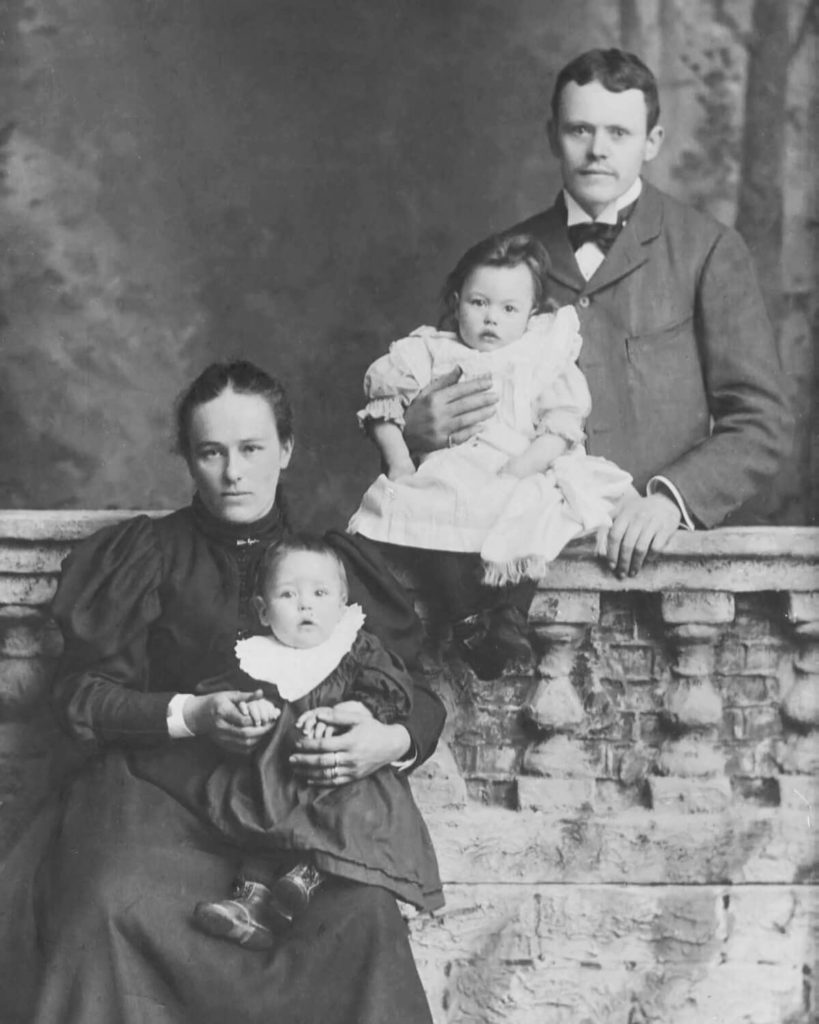
He’d also found time to marry – on June 23, 1893, William married Maria Anna Loeffler at the Long Tower Church in Derry. Maria Anna was herself German (and like William, from the territory of Baden) and the daughter of a clockmaker, Matthew Loeffler.
By 1901 William and Maria Anna had five children ranging in age from seven to one year. They were living at 11 Orchard Street, in the city centre (where Foyleside Shopping Centre is now).
In 1902 William took a ground lease on land overlooking the River Foyle which was newly available for development, (right beside the entrance of the new Victoria Street cattle market built in 1903. The architect Edward Toye was commissioned for the job. He was also responsible for St Columb’s College, the spire of St Eugene’s Cathedral, St Patrick’s Church at Pennyburn and The Playhouse theatre in Artillery Street.
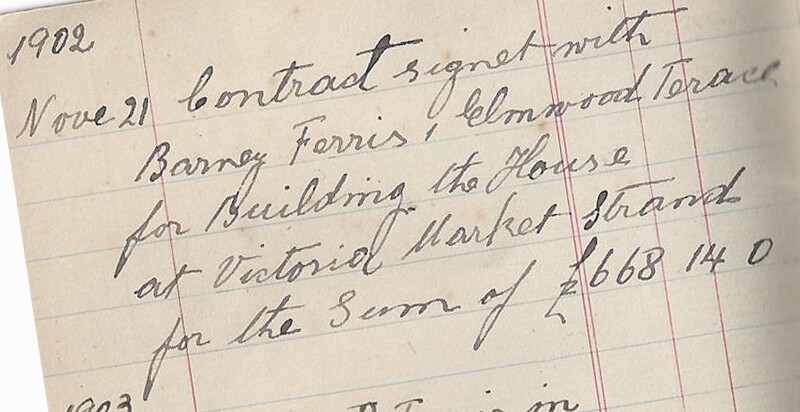
The outcome was a magnificent example of an elegant high-class Victorian jeweller, complete with high ceilings to allow natural light.
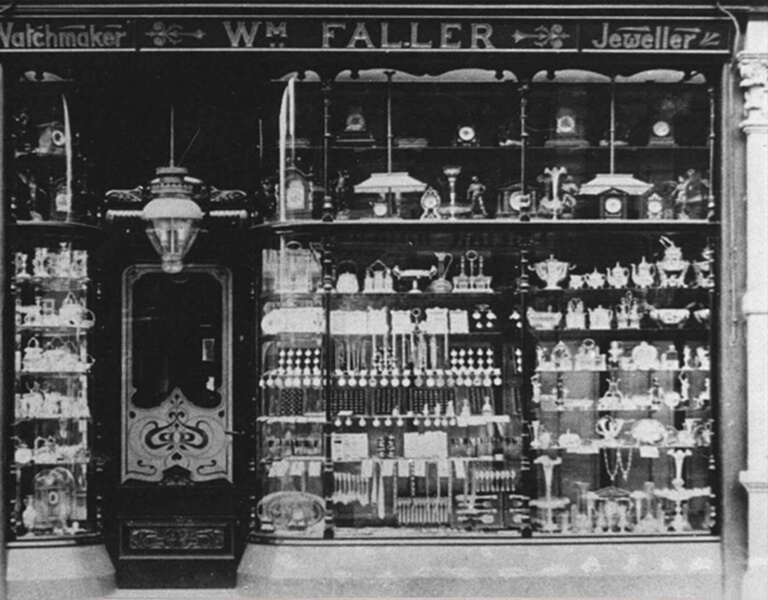

1910's
DERRY was buzzing in the summer of 1914. The Strand Road was one of the city’s main shopping districts – retail heaven stretched as far as the eye could see. Pedestrians crowded the footpaths on either side of the cobbled street as trams, delivery vans and jaunting cars traversed in both directions. Carts, variously laden with oats, potatoes, turnips, turf, and even bogwood, came and went through the arch of Victoria Market – next door to the impressive Victorian facade of Faller’s Jewellers.
For the Faller clan at Orchard Street, life was good. The business had continued to flourish and William and Marianna now had nine mouths to feed: Marianna, David, Elizabeth, William, Emily Francis, Louisa, Theresa, Josephine, and Stephen. A daughter, Monica, was born in April 1915. 16-year-old David had already followed his father into the jewellery business and was working as a watchmaker and repairer. A relative from Germany, Mathew Loeffler, was also boarding with the Faller’s at Orchard Street and working in the shop as a clockmaker and repairer.
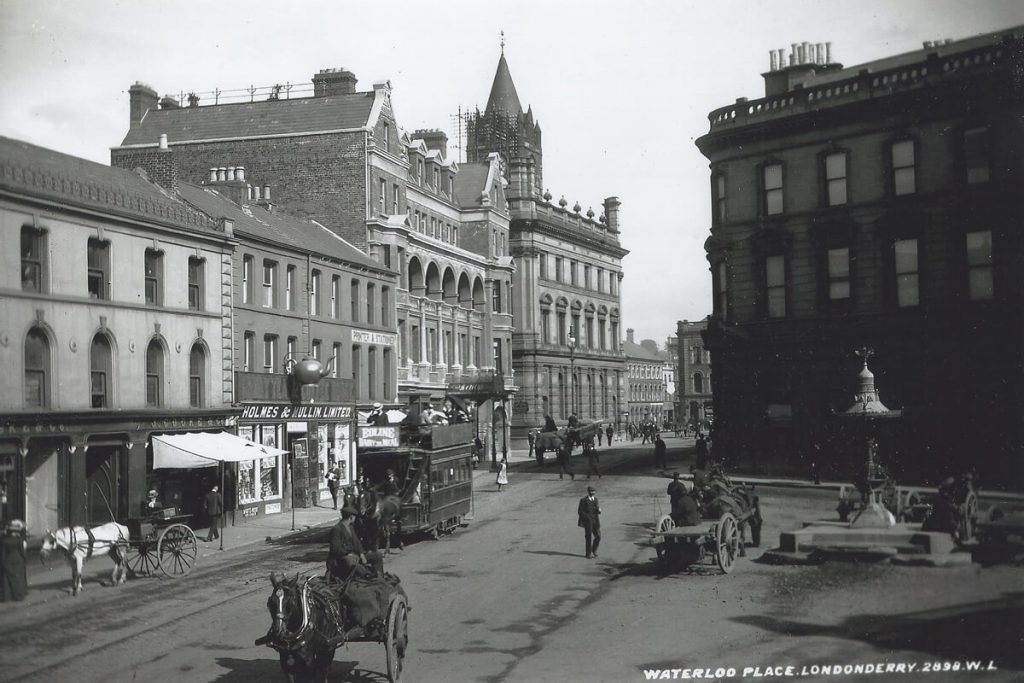
1920’s - 1930’s
But under the veneer of normality, trouble was brewing on the streets of Derry and throughout Ireland. The specter of civil war loomed large over everyday life – an all-out conflict between those in favour of Home Rule and those against. Both the Ulster Volunteer Force and the Irish Volunteers were active in Derry and across the county line in Inishowen.
But much worse was looming in Europe. As events rapidly unfolded on the continent, it came as a huge shock to people in Derry and Donegal – utterly distracted by the threat of civil war – that a world war had materialised on the horizon. “A great European outbreak feared,” noted the Derry Journal of July 31, “A situation of unparalleled gravity.” It certainly was and must have caused William Faller and his German-born relatives in Ireland considerable trepidation. Four years of unprecedented war in Europe that would cost the lives of ten million people – including well over a thousand participants from Derry.
The economically depressed years following the First World War were extremely difficult. Particularly with the volatile political situation between those for and against Home Rule in Ireland, the atmosphere was rife with tension. In June 1920, rioting and street fighting had broken out in the city of Derry.
“During 1920, Derry was in political turmoil with curfews and descended into what could be described as a mini-civil war. Many of those engaged in the defence of the Bogside were war veterans. It was reported that at one of the biggest battles at St Columb’s College, the defenders were mostly ex-soldiers under the command of a Sinn Fein officer.”
The Partition of Ireland took place on 3 May 1921, creating a border between Derry and Donegal and the new border caused the demise of the clock wholesale business in Donegal. William definitely felt its impact on their families’ livelihood.
Stephen Faller (William’s youngest son) joined the family business in 1923 at the age of 15 and like his brother David, learned watch, clock, and jewellery making and repairing.
Therese (William’s daughter) qualified as a dentist in 1927 and Stephen qualified as an optician in 1931. Both set up their practices in adjacent rooms on the middle floor of the Faller building,
Stephen also continued with watch repairs and working in the shop as needed.
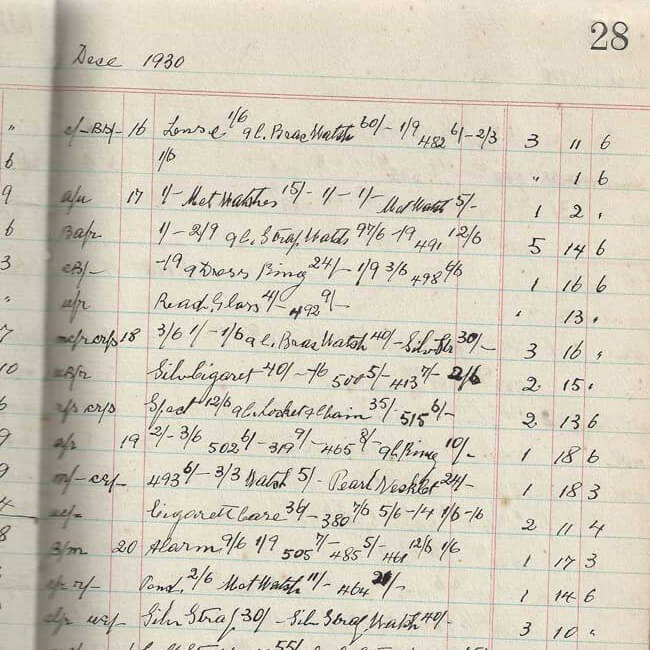
World War Two
With the onset of World War 2 in September 1939, Derry became not only the largest convoy base in the British Isles but also the main American communications base in Europe. As such Derry was considered a particularly attractive target. The blackout procedure had to be strictly observed. No streetlights burned, no familiar signs or clock faces were visible. In every home, the light burning within had to be concealed. Rationing was another wartime necessity for the civilian population. Everyone was issued with a monthly ration book containing coupons.

William Passes Away
William managed to avoid internment, even though he was still a German subject. An RUC officer came from Victoria Barracks, nearby William’s shop, apologised and said he had to intern him unless he became a British subject. William refused stating that he did not feel signing a piece of paper would change him. The Catholic bishop of Derry interceded on Willam’s behalf and the RUC sergeant dropped the demand giving Willam’s age as his reason. The anti-german feeling did impact the business which struggled on through some very hard years.
He didn’t live to learn of the carnage of World War Two – during which his beloved Black Forest didn’t escape either. Aged 80, William passed away at his residence at 11 Orchard Street on April 4, 1940. As the Derry Journal reported at the time: “The business life of Derry city was largely represented at the funeral of Mr. William Faller, Jeweller, whose death at an advanced age is deeply regretted by a large circle of friends. Deceased had been in business in Strand Road, Derry, for over fifty years and was one of the most highly esteemed commercial men in the city.”
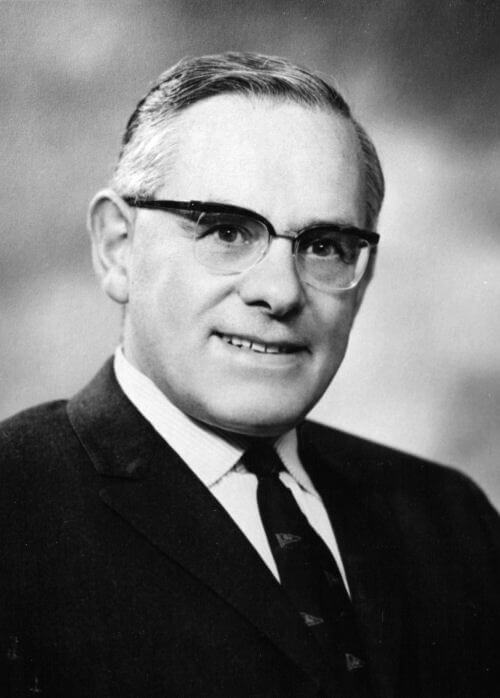
After the death of their father, Stephen and his brother David worked together for 6 years. Business continued to be challenging due to post-war shortages and David left to work in Dublin. Stephen was kept busy between his opticians’ practice, watch repairs and running the shop, working long hours to fit in all his commitments.
He still found time to court Maeve Kelly from Drogheda, Co. Louth. She worked as a nurse in Dublin and he took the train to visit her. After a whirlwind romance, they married in 1947. They lived on the top floor of the shop, The opticians and dental surgery still operated from the 2nd floor.
Their 1st child Desmond, (who unfortunately passed away from TB aged 3 years old in 1951,) was followed by Stephen and Dorothy.
As consumer goods became more readily available business improved. More financially secure Stephen was able to buy a home for his family in Clarence Avenue, moving there in 1952. His youngest children, twins Noel and Dermott were born there.
His wife Maeve joined the business full-time in 1961 and her presence in the shop still continued well into her nineties.
Stephen’s youngest son Noel started helping out in the shop in 1965, initially Saturdays and school holidays, developing skills in jewellery manufacture and repair. While the rest of Stephen’s children went on to other careers Noel’s interest in the family business remained and he joined the business full-time in 1971.
In 1969, fierce riots broke out once more in the city of Derry, the resulting conflict, known as the “Troubles”, would last until 1998. Faller’s shop was lucky to survive this turbulent period with only minor damage, (one cracked 2nd-floor window). Grills were placed on the upper story windows of Fallers to reduce damage by thrown bricks or petrol bombs.

Noels fascination for gemstones led him to study at the Gemmological Institute of Germany and also the Gemmological Institute of America in California. In 1982 he qualified in Gemmology and a year later he became a diamond member of the Gemmological Association.
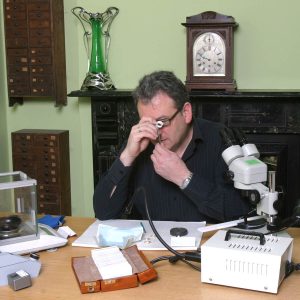
Shop Expansion
In 1983, 100 years since his father first established the business, Stephen purchased the archway next door, previously the entrance to the bus depot. By building a back wall and a full-height glass facade to the front, he was able to virtually double the ground floor shop area. The old fireplace and chimney breast were removed to create internal access to the new section. Care was taken to complement the original Victorian features of the store. The ornate plasterwork ceiling was copied in the new addition. The mantlepiece, ornately painted mirror, original cabinets, and counters were moved into the new space. New glass and brass counters were purchased to take advantage of now vacant space in the original area.
In 1988 a workshop was created on the top floor. Previously repairs were carried out in the back of the shop, Hugh Stewart worked there until he retired in 1992.
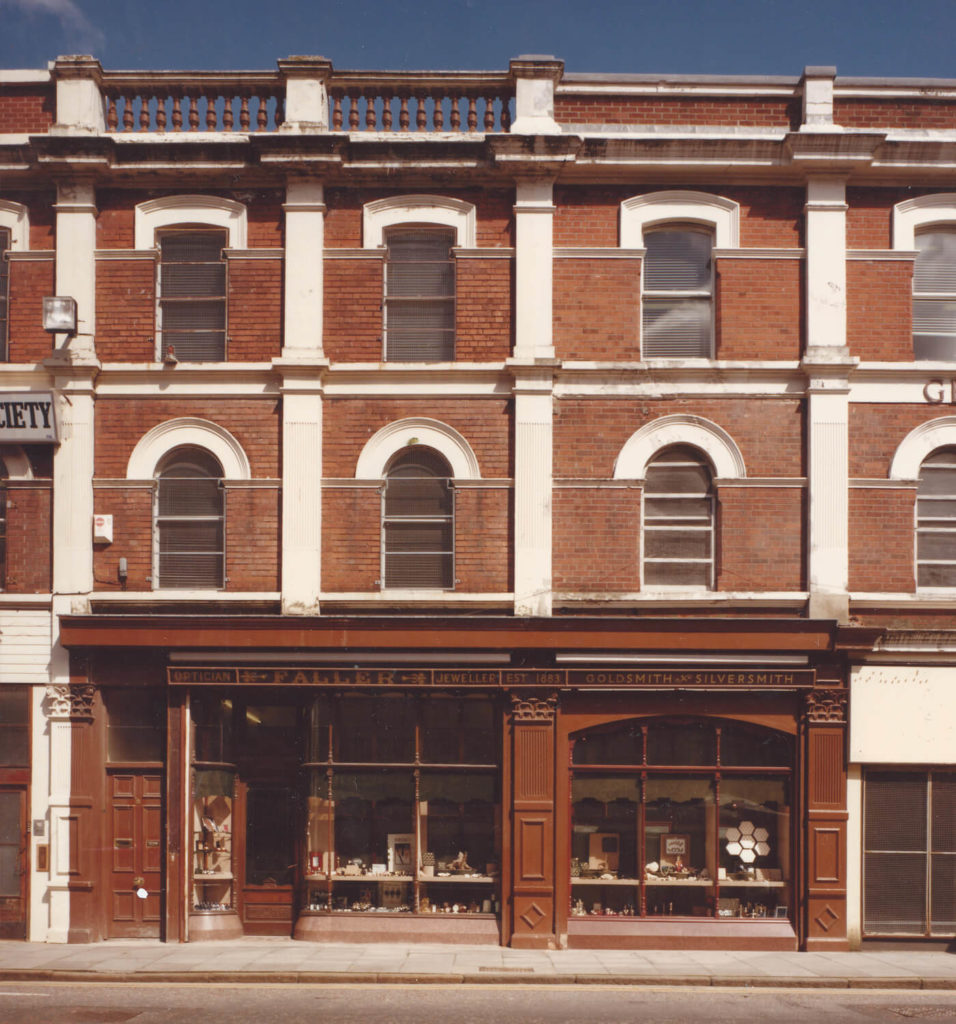


1990's
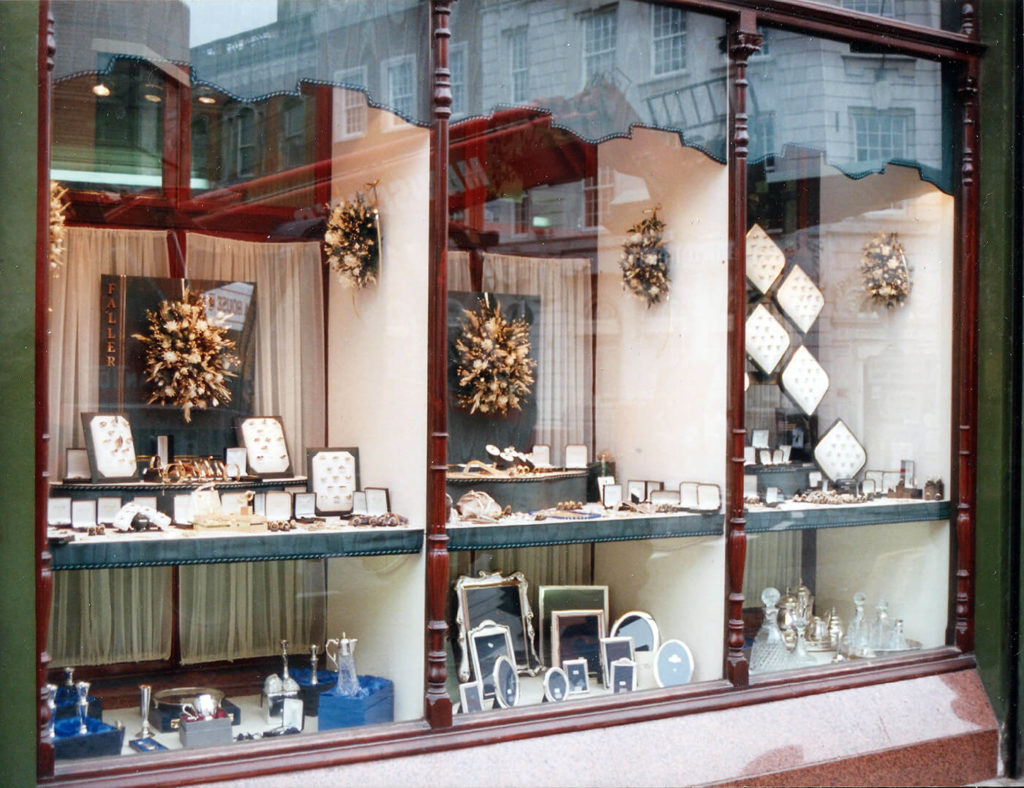
Faller shop window 1992
As time went on, Noel played an increasing role in how the shop was run, building on his knowledge and experience. With his father’s encouragement, Noel initiated his ideas to encourage business growth. The excellent skills and knowledge that he developed in diamond and gemstone sourcing and grading helped him to increase the range and quality of stone set jewellery sold by Faller.
New goldsmiths were employed and the workshop was also expanded and developed, increasing its production capabilities. Our current designer and goldsmith Una Carlin joined in 1996.
Faller’s first website was launched in 1998.
Stephen Faller remained the proprietor of Faller until he passed in 1999 at the age of 91. His son Noel, taking charge after this sad loss.

2000's - Workshop Expansion
Noel developed his vision for the future of Faller. While still keeping the core values of quality, value, and service, he wanted to increase the individuality and choice available to our clientele by increasing the range of jewellery exclusively designed and made by Faller.
As interest in platinum jewellery increased new skills and machinery were introduced to achieve the quality we expect of our Faller product. In September 1999 Noel, along with the Steensons of Glenarm, County Antrim purchased the first laser welders in Ireland. Giving the workshop the ability to seamlessly weld platinum and gold.
Four new goldsmiths (Irish and German) joined Faller between 2000 – 2006.
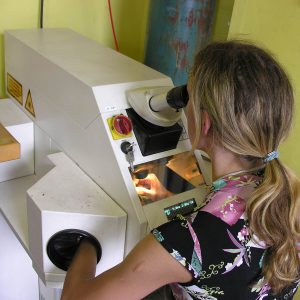

In 2003 Una trained in CAD (computer-aided design) and designed new jewellery ranges which were produced in our workshop.
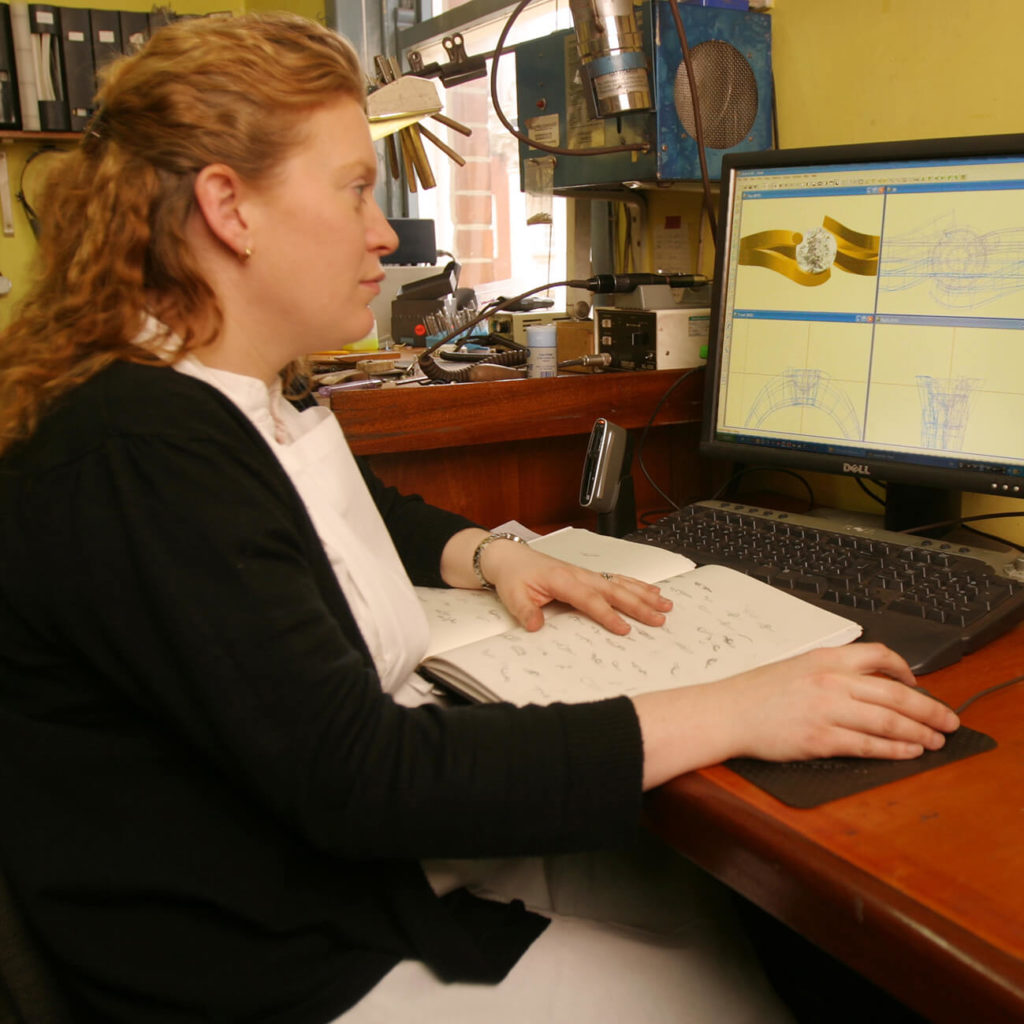
In 2005 the addition of a German Benzinger wedding ring lathe and a Swiss Posalux lathe give the workshop the ability to profile and pattern grooved lines on wedding rings using diamond tools.
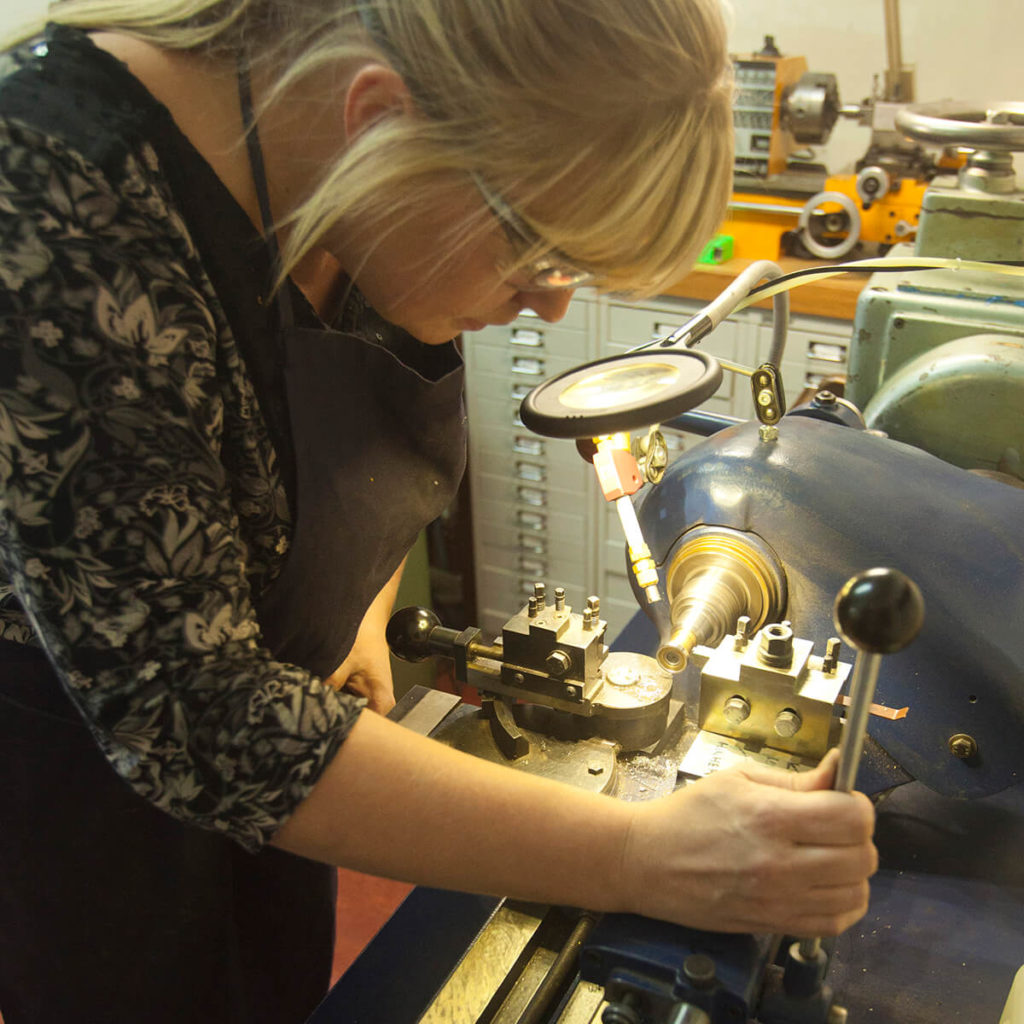
In 2006 a deep laser marker was installed, again a first for a jewellery manufacturer in Ireland. This allowed us to personalise and pattern rings and other jewellery. The intricate collage on Drop of Derry jewellery wouldn’t be possible without it. View our Video Clips to see this process in action.


In 2006 our second website was launched.
Faller began with timepieces but over the years that emphasis has changed. In 2007 the decision was made to phase out watch retailing completely to increase our focus on jewellery designed and made by Faller.
In 2009 Faller launched part of our FallerOriginal Heritage range – High Crosses of Inishowen and the Oakleaf Brooch.

Installing a vacuum enclosed casting system in 2011 allowed is to bring all our casting of platinum, gold, and silver in-house.
Madonna, one of our goldsmiths who joined Faller as an apprentice underwent training by Master Stone-setters in Germany and Holland. She has since become a highly skilled stone-setter. From 2013 on, all stone setting has been carried out in our workshop.
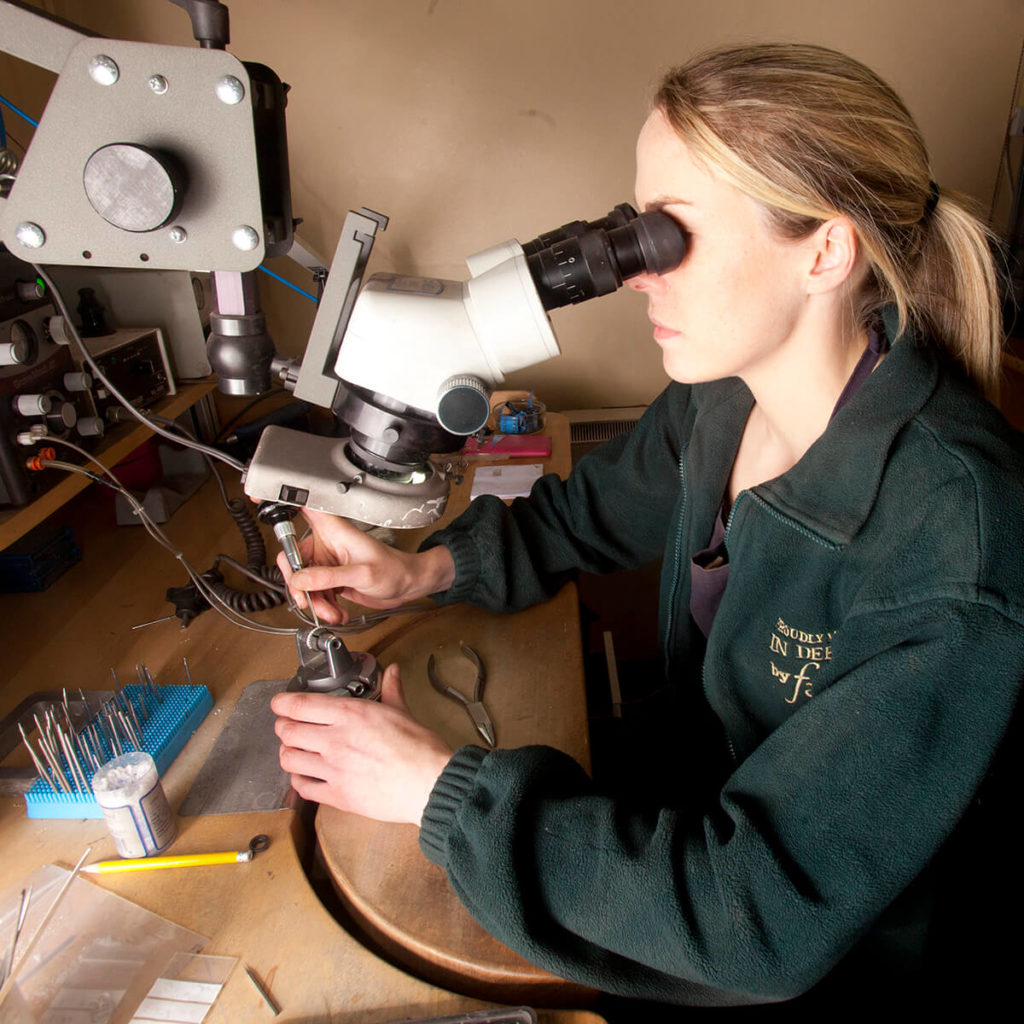
Early in the morning of the 20th of January 2013, the “Golden Teapot” was installed on the façade of Faller. This marked the 130th year since the first Faller shop was opened in Derry city. The huge gold-leafed ornamental teapot trade sign originally hung in Waterloo Place from 1866. Noel Faller bought it from Mrs Jean McCullagh in 1974 after the Teapot was taken down from permanent display in the 1970’s. The teapot was kept safely in storage throughout the turbulent era of the troubles.
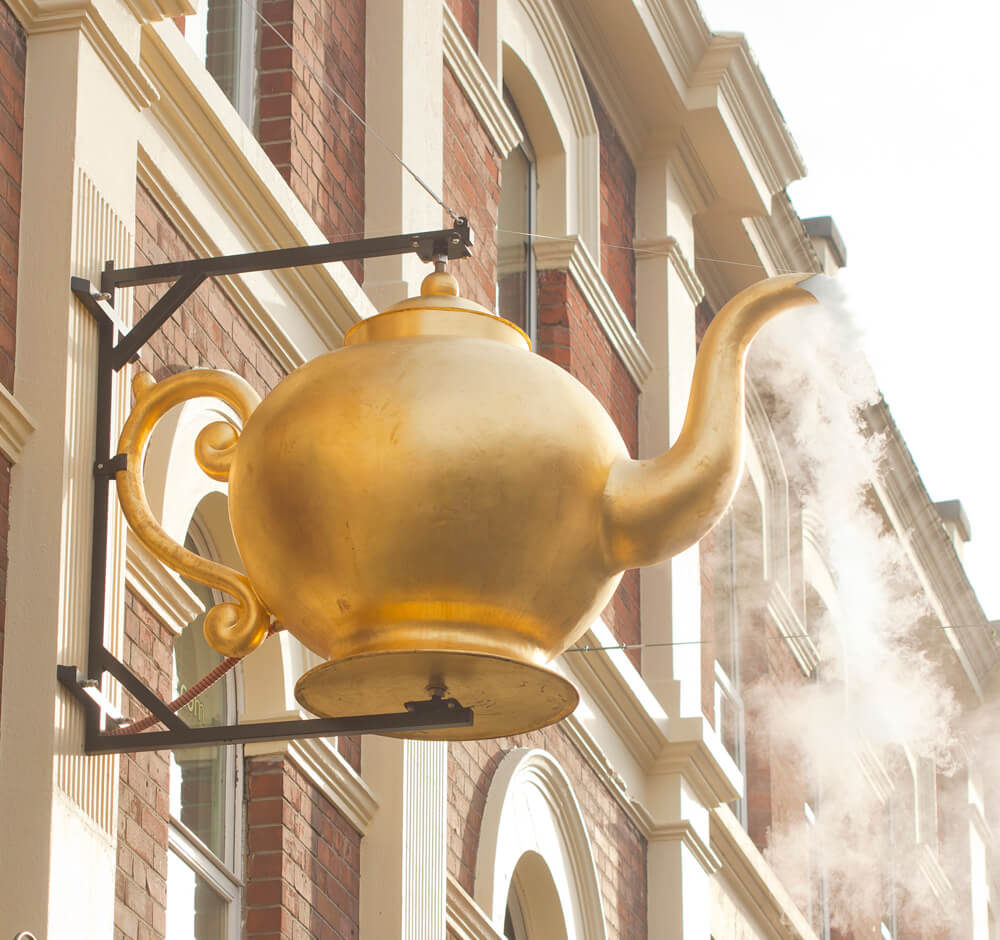
While we have been using CAD since 2003, CAM (computer-aided manufacture) was still out-sourced. In 2018 we upgraded our CAD program and purchased a 3-D printer, finally allowing us to be become fully vertically integrated, from design to final product, with all production processes in-house. By July 2017 over 90% of Faller product by value is designed and crafted in our workshop above the shop.
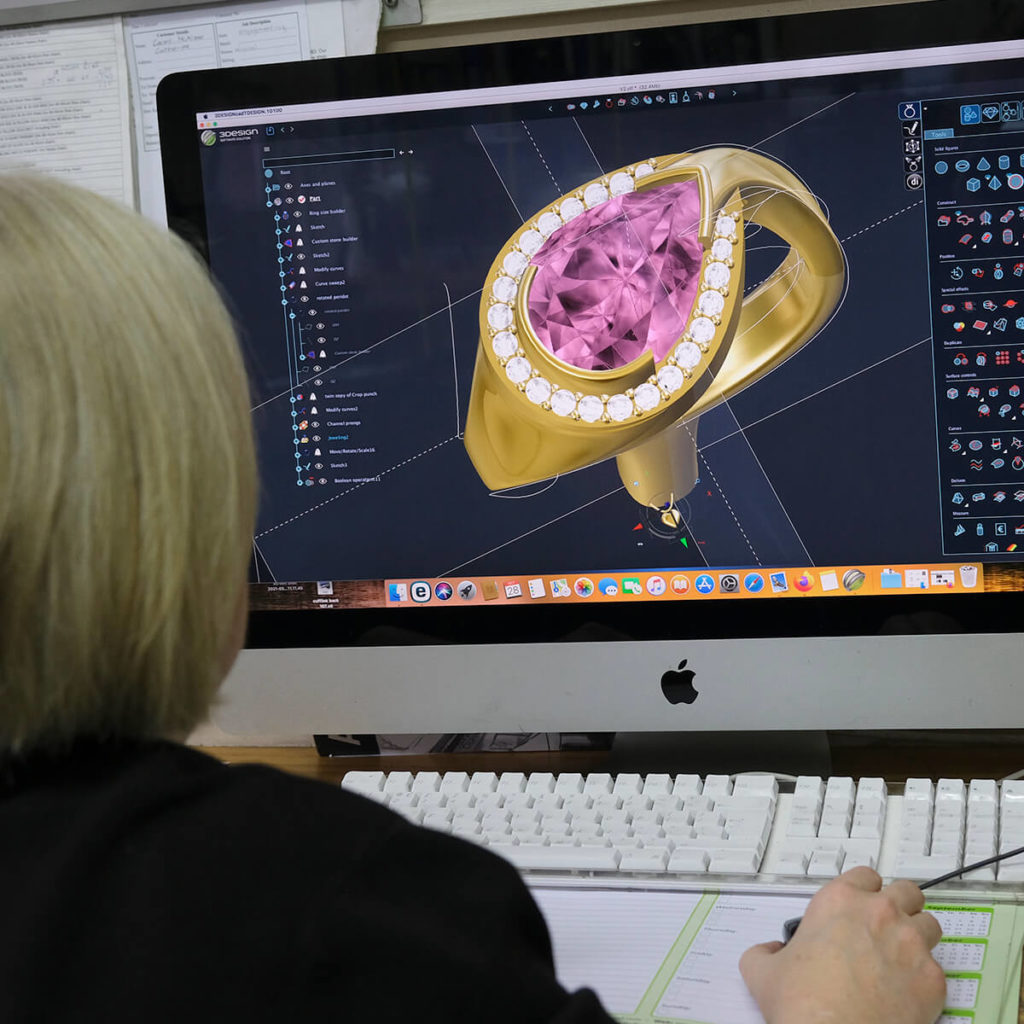
We have hugely expanded our range of gemstone jewellery and this has become our main area of expertise. A number of gem buying trips to Europe and Bangkok were necessary to obtain new direct gem sources.
To increase Madonna’s knowledge of coloured gemstones she undertook a Distance Learning G.I.A. Coloured Stones Course and was awarded a Coloured Stone Certificate by the G.I.A. on completion. She covered a wide range of gem types, learning their characteristics and how to identify them. This in-depth knowledge improves her ability to select the right gems on buying trips and also her ability to stone-set the wide variety of gems in our Faller jewellery.

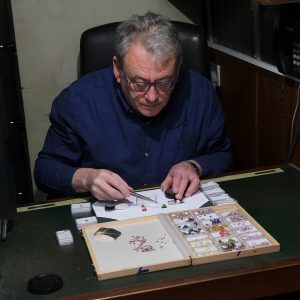
We now offer an extensive range of gemstones at different price points and this facet of Faller production continues to grow. We are now the leading supplier of designer gemstone jewellery in the whole of Ireland.
Sometimes the old ways remain the best and we now use our large reconditioned flypress to produce our own earring backs and have added our own unique version of the Miraculous Medal to our religious jewellery range. This uses the same techniques used hundreds of years ago to emboss and press out jewellery parts.
Also the 50 ton hydraulic press we purchased has allowed us to create our exclusive Baby spoons and increase the range of bangles we produce.

Present Day
We continue to expand our Faller Original Heritage and Designer Jewellery Collections and have three new collections planned for the year ahead.
